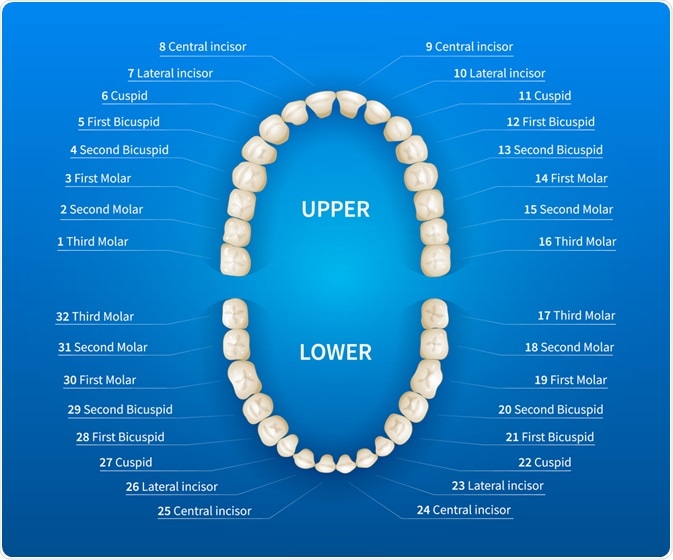Tooth numbering is a notation used by dentists to denote and specify information linked with a particular tooth. Using a tooth numbering system allows for easy identification, communication, and dental record maintenance in an easy and a precise manner.
Tooth numbering serves various purposes like helping to identify and classify the condition associated with the concerned tooth both clinically and radiographically. This allows easy communication among the dental professionals to assess and treat dental disease. Globally, there are several different tooth numbering systems.
Some commonly used systems are the Zsigmondy-Palmer system, Universal Numbering System, and the FDI system numbering system. Among these systems, Zsigmondy-Palmer system is the oldest and by far the most widely used. Zsigmondy-Palmer system was introduced in 1861 and is popularly called Palmer’s notation among dental professionals. Some other systems are the Victor Haderup system, Woelfel system, and MICAP system.
Even though most tooth numbering systems focus on classifying permanent teeth, notations for deciduous (milk) teeth are also available under each system, particularly to understand the deciduous dentition more accurately.

What are dental quadrants?
Understanding dental quadrants is important for understanding tooth numbering systems. Dentists divide the whole dentition into four quadrants or sections. The upper arch has two sections, upper right and upper left sections, which are named first and second quadrants, respectively. Similarly, the lower jaw has the third and fourth quadrants. Dental charts are prepared from the perspective of the dentist, wherein the right side is shown on the left side of the chart and vice-versa.
Dental quadrants also allow a quick and easy understanding of the concerned tooth. All naming systems require an understanding of quadrants so that a specific tooth located in a particular quadrant acquires the designated name.
What is the Universal Numbering System?
A universal tooth numbering system was first proposed in the year 1882 by German dentist Julius Parreidt. Under this naming system, primary and permanent teeth are named differently. This naming system is accepted and approved by the American Dental Association (ADA) and is the most commonly naming system used by dental professionals in America. One drawback of this naming system is that it fails to classify supernumerary (extra) teeth. However, the main advantage of this system is that it follows a sequential pattern of naming teeth and can be easily understood in locating the concerned tooth. Owing to its easy understanding ADA accepted this nomenclature in 1968.
How are primary teeth are named under Universal Numbering System?
While numbering the primary teeth under this system, the naming begins from the upper arch (both the quadrants), starting with the letter A and proceeding sequentially through J. Naming of primary teeth begins with the posterior part of the upper right quadrant where the right second molar tooth is assigned the name A, and follows around until letter J, the left second molar on the left posterior side of the dental arch.
This naming follows a similar pattern on the lower arch, where the right second molar is denoted by the letter T. Naming is in reverse alphabetical order around to K, which is designated to the lower second left molar. It is important to note that while numbering the primary teeth the tooth naming is assigned only in upper case following from A till T.
Naming permanent teeth under Universal Numbering System
Permanent teeth are also assigned numbers sequentially. The naming starts from the posterior most region of the upper first quadrant and each tooth is numbered from 1 to 32 in a sequential pattern. The numbering starts from the third molar tooth where the upper right third molar is assigned the number 1. This naming system follows a sequential pattern and continues until the left third molar tooth, which is numbered as 16. The similar pattern follows in the lower dentition wherein the lower left third molar in the third quadrant is assigned number 17, and a sequential pattern ends with number 32 with lower right molar tooth.
Below is the sequential naming pattern of Universal Numbering System as designated by ADA:
- Number 1: 3rd Molar commonly known as wisdom tooth
- Number 2: 2nd Molar
- Number 3: 1st Molar
- Number 4: 2nd Bicuspid also known as 2nd premolar
- Number 5: 1st Bicuspid or 1st premolar
- Number 6: Cuspid or canine
- Number 7: Lateral incisor (upper right)
- Number 8: Central incisor (upper right)
- Number 9: Central incisor (upper left)
- Number 10: Lateral incisor (upper left)
- Number 11: Cuspid (canine/eye tooth)
- Number 12: 1st Bicuspid or 1st premolar
- Number 13: 2nd Bicuspid or 2nd premolar
- Number 14: 1st Molar
- Number 15: 2nd Molar
- Number 16: 3rd Molar or wisdom tooth
- Number 17: 3rd Molar or wisdom tooth (lower left )
- Number 18: 2nd Molar
- Number 19: 1st Molar
- Number 20: 2nd Bicuspid or 2nd premolar
- Number 21: 1st Bicuspid or 1st premolar
- Number 22: Cuspid or canine
- Number 23: Lateral incisor
- Number 24: Central incisor
- Number 25: Central incisor
- Number 26: Lateral incisor
- Number 27: Cuspid or canine
- Number 28: 1st Bicuspid or 1st premolar
- Number 29: 2nd Bicuspid or 2nd premolar
- Number 30: 1st Molar
- Number 31: 2nd Molar
- Number 32: 3rd Molar (lower right wisdom tooth)
Sources
- https://www.ncbi.nlm.nih.gov/pubmed/26147826
- https://www.ncbi.nlm.nih.gov/pubmed/2489508
- https://www.ncbi.nlm.nih.gov/pmc/articles/PMC5110463/#b0070
- web.archive.org/…/tooth_number.asp
- www.ijdr.in/article.asp
- www.dentalage.co.uk/…/elderton_tooth_notation_bdj_jan_891.pdf
Further Reading
- All Teeth Content
- Dental Health in Children
- Foods Good for Teeth
- Tooth Polishing Procedure
- When Should Children Get Their Adult Teeth?
Last Updated: Apr 23, 2019

Written by
Akshima Sahi
Akshima is a registered dentist and seasoned medical writer from Dharamshala, India. Akshima is actively involved in educating people about the importance of good dental health. She examines patients and lends free counseling sessions. Taking her passion for medical writing ahead, her aim is to educate the masses about the value of good oral health.
Source: Read Full Article
